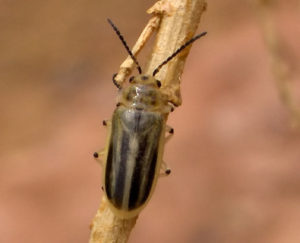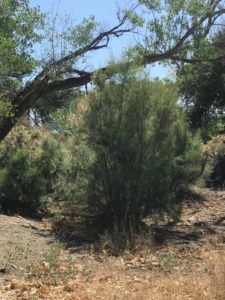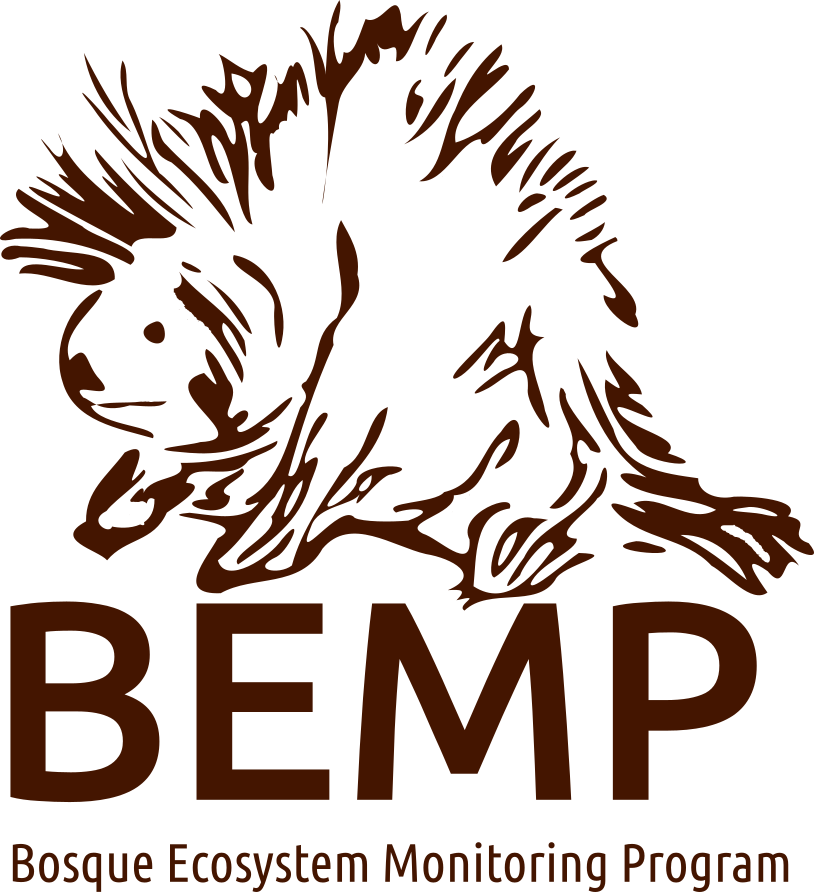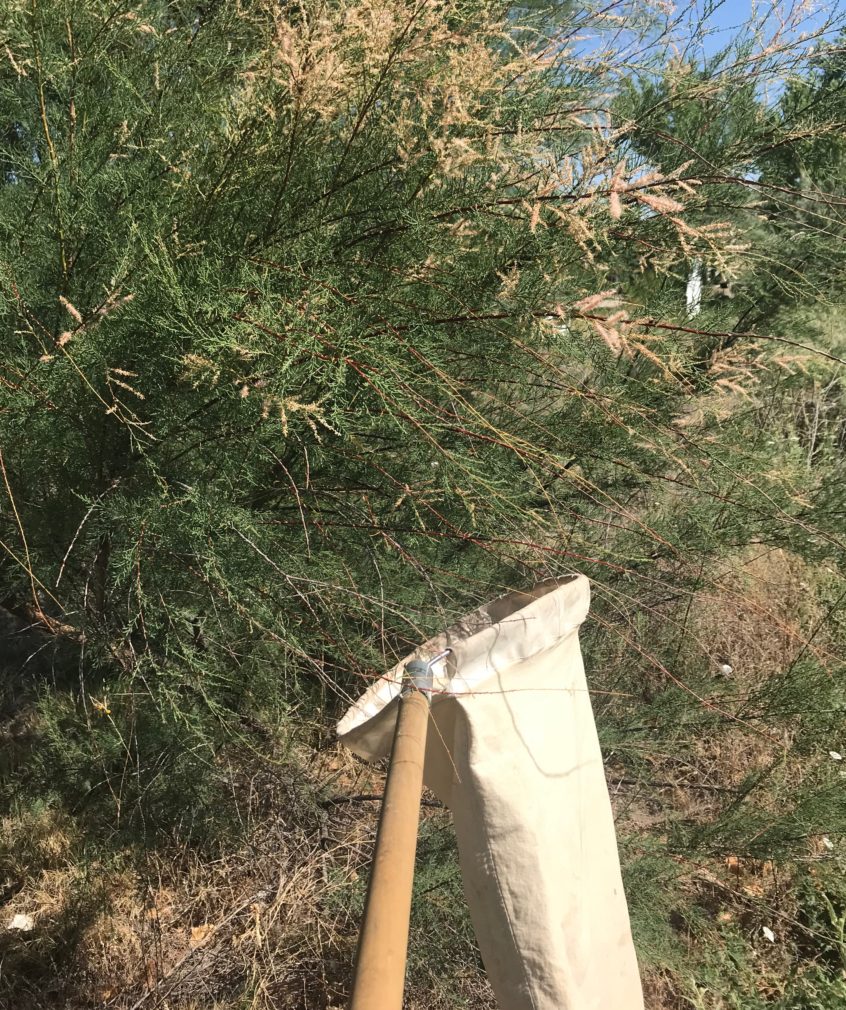TLB Romping and A Retrospective
By Jonathan Tyrrell
As I mark the calendar of a year-long anniversary of working at BEMP, I am excited to step into new horizons, learn about new datasets, and establish stronger connections to the bosque ecosystem and those who work to monitor it. This past year has taught me how BEMP is a microcosm of the Rio Grande bosque ecosystem’s multifaceted connectivity. Each BEMP staff member brings vitality and a unique force to our ecosystem, all driven to take root and germinate in the flood of Dr. Cliff Crawford’s vision. As I continue to grow as one of his sapling trees in BEMP’s watershed, I find my roots tapping into new water in the collection of the tamarisk leaf beetle (TLB) dataset, now in the summer of 2018.
 In a diversion from monthly monitoring, fellow TLB intern (and former Crawford Fellow) Keara Bixby and I found ourselves chasing the tamarisk leaf beetle on the salt cedar (or Tamarisk) trees along the river. This summer, we are monitoring salt cedars at 17 sites north, south, and in the Albuquerque area. With a nod to Keara’s expertise of the dataset, I am excited to plunge into better understanding the relationship between beetle and tree, and how that relationship affects the ecosystem at large.
In a diversion from monthly monitoring, fellow TLB intern (and former Crawford Fellow) Keara Bixby and I found ourselves chasing the tamarisk leaf beetle on the salt cedar (or Tamarisk) trees along the river. This summer, we are monitoring salt cedars at 17 sites north, south, and in the Albuquerque area. With a nod to Keara’s expertise of the dataset, I am excited to plunge into better understanding the relationship between beetle and tree, and how that relationship affects the ecosystem at large.
 The tamarisk leaf beetle was introduced as a method of biocontrol for the invasive tamarisk species in Texas, Utah, and Colorado. As these beetles have migrated into New Mexico along the Rio Grande, BEMP has joined the effort to monitor their activity and behavior over time in the ecosystem. It feels good to be the boots on the ground, to be on the front lines of understanding beetle behavior.
The tamarisk leaf beetle was introduced as a method of biocontrol for the invasive tamarisk species in Texas, Utah, and Colorado. As these beetles have migrated into New Mexico along the Rio Grande, BEMP has joined the effort to monitor their activity and behavior over time in the ecosystem. It feels good to be the boots on the ground, to be on the front lines of understanding beetle behavior.
While we were hoping the early birds caught the worm – or beetle, in this case – the beetles have eluded our TLB team. While there is still hope in the lab (Keara is sorting and identifying our data as I write this), our quick visible inspections of data in the field yielded no beetles. We might be a bit early – last year’s data suggests the beetles are much less present in May than later in the summer.
Nonetheless, it was fun to do a quick tour of many sites last week. On Tuesday and Wednesday, we stayed in town, although both days felt like just a warm-up for our long day out of town. In town, some notable events at BEMP sites were a coyote spotting at Calabacillas, feeling beachlike sand on the banks of the river at AOP, and almost going to San Jose instead of Harrison (sometimes our brains wake up a little slower than our bodies).
 On Thursday, we made the trek down to Valencia County for a full field day. After getting lost at the Crawford site (you might notice a common theme here), we quickly whacked some salt cedars with our bug net and drove up the levee road to Valencia Cleared, which went without a hitch (but plenty of tumbleweed and kochia). Our quick monthly monitoring and TLB collections at the Reynolds sites was uneventful, with a brief interruption thanks to some missing landmarks (via a levee clearing) and gawking at a big white truck driving through a very dry river. As we wound down the day at the sites in Los Lunas and Bosque Farms, we began to feel the heat of the afternoon sun. After getting lost for a third (and final!) time on the way into the Bosque Farms site, the final collection of the week seemed to be our longest.
On Thursday, we made the trek down to Valencia County for a full field day. After getting lost at the Crawford site (you might notice a common theme here), we quickly whacked some salt cedars with our bug net and drove up the levee road to Valencia Cleared, which went without a hitch (but plenty of tumbleweed and kochia). Our quick monthly monitoring and TLB collections at the Reynolds sites was uneventful, with a brief interruption thanks to some missing landmarks (via a levee clearing) and gawking at a big white truck driving through a very dry river. As we wound down the day at the sites in Los Lunas and Bosque Farms, we began to feel the heat of the afternoon sun. After getting lost for a third (and final!) time on the way into the Bosque Farms site, the final collection of the week seemed to be our longest.
As I stumbled around the Bosque Farms site, I reflected on the year I had spent with BEMP, in now three distinct capacities – High School intern, Crawford Fellow, and now a TLB intern. Being part of the BEMP team has been superfood for this young sapling, as he planted his roots in the BEMP office in Castetter Hall and grew his leaves to explore UNM’s campus and the city of Albuquerque. As I continue to grow, I am glad to have a home in the BEMP family, as one of Cliff’s grandkids.

Jonathan Tyrrell, BEMP TLB Intern

